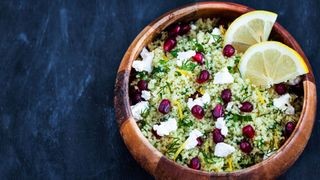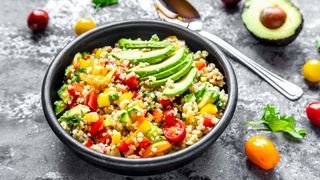Is Couscous A Low Carb Food? Explore its nutritional profile, benefits, and creative ways to enjoy couscous while managing your carbohydrate intake, all brought to you by FOODS.EDU.VN. Discover low-carb alternatives and delicious recipes to satisfy your cravings without compromising your dietary goals. Consider couscous a versatile grain alternative or a delightful addition to your healthy lifestyle today.
1. Understanding Couscous: What Is It?
Couscous, often mistaken for a grain, is actually made from small, steamed granules of semolina, a type of durum wheat. This versatile ingredient is a staple in North African cuisine and has gained popularity worldwide for its ease of preparation and mild flavor. Couscous is incredibly versatile; it can be served as a side dish, a base for salads, or even incorporated into main courses. The quick-cooking nature of couscous makes it a convenient option for busy weeknights.
1.1 Types of Couscous
There are three primary types of couscous:
- Moroccan Couscous: The smallest variety, it cooks the fastest and is ideal for light, fluffy dishes.
- Israeli Couscous (Pearl Couscous): Larger, round pearls with a chewier texture. It takes longer to cook and can be used in salads or as a pilaf.
- Lebanese Couscous: The largest type, also known as Moghrabieh, offering a substantial bite and often used in stews and tagines.
1.2 Nutritional Profile of Couscous
A 100-gram serving of cooked couscous typically contains:
| Nutrient | Amount |
|---|---|
| Calories | 112 |
| Carbohydrates | 23g |
| Protein | 3.8g |
| Fat | 0.2g |
| Fiber | 1.4g |
| Selenium | 37% DV |


Couscous also contains essential minerals like selenium, which acts as an antioxidant and supports thyroid function. However, it is relatively low in fiber compared to other whole grains.
2. Is Couscous a Low Carb Option?
When it comes to low-carb diets, understanding the carbohydrate content of your food is crucial. Given that couscous contains approximately 23 grams of carbohydrates per 100-gram serving, it is generally not considered a low-carb food. Low-carb diets typically restrict carbohydrate intake to below 100 grams per day, and some stricter plans may limit it to as low as 20-50 grams per day.
2.1 Carbohydrate Content Compared to Other Grains
To provide a clearer perspective, let’s compare the carbohydrate content of couscous with other common grains and low-carb alternatives:
| Food | Carbohydrates per 100g |
|---|---|
| Couscous | 23g |
| White Rice | 28g |
| Quinoa | 21g |
| Brown Rice | 23g |
| Cauliflower Rice | 5g |
| Shirataki Rice | 3g |
As the table indicates, couscous has a carbohydrate content similar to brown rice and quinoa but significantly higher than low-carb options like cauliflower rice and shirataki rice.
2.2 Glycemic Index (GI) and Glycemic Load (GL)
The glycemic index (GI) measures how quickly a food raises blood sugar levels. Foods with a high GI are rapidly digested and absorbed, leading to a quick spike in blood sugar. The glycemic load (GL) takes into account both the GI and the serving size of the food.
Couscous has a moderate glycemic index, typically around 65, and a glycemic load of about 16 per 100-gram serving. This means that it can cause a moderate rise in blood sugar levels, particularly if consumed in larger portions. People with diabetes or insulin resistance should be mindful of portion sizes and consider pairing couscous with protein and fiber-rich foods to mitigate blood sugar spikes.
3. Health Benefits of Couscous
Despite not being a low-carb option, couscous offers several health benefits when consumed in moderation as part of a balanced diet.
3.1 Rich in Selenium
Couscous is a good source of selenium, an essential mineral with antioxidant properties. Selenium helps protect the body against cell damage, supports immune function, and is crucial for thyroid hormone metabolism.
3.2 Plant-Based Protein
Couscous contains plant-based protein, which is essential for building and repairing tissues. While it is not a complete protein (meaning it doesn’t contain all nine essential amino acids), it can contribute to your daily protein intake, especially when combined with other protein-rich foods.
3.3 Source of Energy
As a carbohydrate-rich food, couscous provides a readily available source of energy. This can be beneficial for active individuals or those needing a quick energy boost.
Image: Couscous, as seen at FOODS.EDU.VN, with vegetables and herbs provides a colorful and nutritious meal option, perfect for adding variety to your diet.
4. Who Should Limit Couscous Intake?
While couscous can be part of a healthy diet for many, certain individuals may need to limit or avoid it:
4.1 People on Low-Carb Diets
Those following strict low-carb diets, such as the ketogenic diet, should avoid couscous due to its high carbohydrate content. The keto diet aims to keep carbohydrate intake very low to induce ketosis, a metabolic state where the body burns fat for fuel instead of carbohydrates.
4.2 Individuals with Diabetes or Insulin Resistance
People with diabetes or insulin resistance should monitor their couscous consumption and be mindful of portion sizes. Couscous can raise blood sugar levels, so it’s best to pair it with protein, healthy fats, and fiber to minimize blood sugar spikes.
4.3 People with Gluten Sensitivity or Celiac Disease
Traditional couscous is made from semolina, a type of wheat that contains gluten. Therefore, individuals with gluten sensitivity, celiac disease, or wheat allergies should avoid traditional couscous. However, gluten-free couscous alternatives made from rice, corn, or quinoa are available.
5. Low-Carb Alternatives to Couscous
If you’re looking for low-carb alternatives to couscous, several options can satisfy your cravings without the added carbohydrates.
5.1 Cauliflower Couscous
Cauliflower couscous is a fantastic low-carb alternative made by pulsing raw cauliflower florets in a food processor until they resemble couscous granules. It has a mild flavor and can be used in various dishes, from salads to side dishes.
Nutritional Information (per 100g):
- Calories: 25
- Carbohydrates: 5g
- Fiber: 2g
5.2 Broccoli Couscous
Similar to cauliflower couscous, broccoli couscous is made by pulsing raw broccoli florets in a food processor. It has a slightly stronger flavor than cauliflower but is equally versatile and nutritious.
Nutritional Information (per 100g):
- Calories: 34
- Carbohydrates: 7g
- Fiber: 3g
5.3 Shirataki Rice
Shirataki rice is made from konjac root and is very low in carbohydrates and calories. It has a slightly chewy texture and can be used as a rice or couscous substitute in various dishes.
Nutritional Information (per 100g):
- Calories: 9
- Carbohydrates: 3g
- Fiber: 3g
5.4 Hemp Seeds
Hemp seeds, while not exactly like couscous in texture, can provide a similar base for salads and bowls. They are low in carbs and high in protein and healthy fats.
Nutritional Information (per 100g):
- Calories: 553
- Carbohydrates: 8.7g
- Fiber: 4g
- Protein: 31.6g
- Fat: 48.8g
6. Delicious Low-Carb Couscous Recipes
Even if you’re watching your carb intake, you can still enjoy couscous-inspired dishes using low-carb alternatives. Here are a few creative and delicious recipes to try.
6.1 Cauliflower Couscous Salad with Lemon-Herb Vinaigrette
This refreshing salad is perfect for a light lunch or side dish.
Ingredients:
- 1 medium head of cauliflower, pulsed into couscous
- 1/2 cup chopped cucumber
- 1/2 cup chopped tomatoes
- 1/4 cup chopped red onion
- 1/4 cup chopped fresh parsley
- 2 tablespoons olive oil
- 2 tablespoons lemon juice
- 1 clove garlic, minced
- Salt and pepper to taste
Instructions:
- Prepare the cauliflower couscous by pulsing cauliflower florets in a food processor.
- In a large bowl, combine the cauliflower couscous, cucumber, tomatoes, and red onion.
- In a small bowl, whisk together olive oil, lemon juice, minced garlic, salt, and pepper.
- Pour the dressing over the salad and toss gently to combine.
- Garnish with fresh parsley and serve.
6.2 Broccoli Couscous Bowl with Grilled Chicken
This hearty and nutritious bowl is packed with flavor and protein.
Ingredients:
- 1 medium head of broccoli, pulsed into couscous
- 4 oz grilled chicken breast, sliced
- 1/2 avocado, diced
- 1/4 cup roasted red peppers, chopped
- 2 tablespoons olive oil
- 1 tablespoon lemon juice
- Salt and pepper to taste
Instructions:
- Prepare the broccoli couscous by pulsing broccoli florets in a food processor.
- In a bowl, combine the broccoli couscous, sliced grilled chicken, avocado, and roasted red peppers.
- Drizzle with olive oil and lemon juice, then season with salt and pepper.
- Toss gently to combine and serve.
6.3 Shirataki Rice Couscous with Shrimp and Vegetables
This light and flavorful dish is perfect for a quick and easy weeknight meal.
Ingredients:
- 1 package shirataki rice, rinsed and drained
- 1/2 lb shrimp, peeled and deveined
- 1 cup mixed vegetables (e.g., bell peppers, zucchini, onions), chopped
- 2 tablespoons olive oil
- 1 clove garlic, minced
- 1 tablespoon soy sauce (or coconut aminos for a gluten-free option)
- Salt and pepper to taste
Instructions:
- Heat olive oil in a large skillet over medium heat.
- Add minced garlic and mixed vegetables and cook until tender.
- Add shrimp and cook until pink and opaque.
- Add shirataki rice and soy sauce (or coconut aminos) to the skillet.
- Season with salt and pepper and toss to combine.
- Cook for a few minutes until heated through and serve.
7. Couscous in Different Cuisines
Couscous is a versatile ingredient that has been adapted into various cuisines around the world. Let’s explore how it’s used in different culinary traditions.
7.1 North African Cuisine
In North Africa, particularly in countries like Morocco, Algeria, and Tunisia, couscous is a staple food. It’s often served as the base for hearty stews and tagines, featuring meats, vegetables, and aromatic spices.
- Moroccan Tagine: A slow-cooked stew with meat (such as lamb or chicken), vegetables, and dried fruits, served over a bed of fluffy couscous.
- Algerian Couscous with Vegetables: A vegetarian dish with a variety of seasonal vegetables, chickpeas, and a flavorful broth, served over couscous.
- Tunisian Couscous with Fish: A spicy dish with fish, vegetables, and harissa paste, served over couscous.
7.2 Mediterranean Cuisine
Couscous has also found its way into Mediterranean cuisine, where it’s often used in salads and as a side dish with grilled meats or seafood.
- Israeli Couscous Salad: A refreshing salad with pearl couscous, vegetables, herbs, and a lemon-herb vinaigrette.
- Couscous with Grilled Vegetables: A simple and healthy dish with grilled vegetables (such as zucchini, eggplant, and bell peppers) served over couscous.
- Couscous with Seafood: A flavorful dish with seafood (such as shrimp, mussels, and calamari) sautéed with vegetables and herbs, served over couscous.
7.3 Global Adaptations
Beyond North Africa and the Mediterranean, couscous has been adapted into various global cuisines, with chefs and home cooks experimenting with different flavors and ingredients.
- Couscous with Asian-Inspired Flavors: A fusion dish with couscous, stir-fried vegetables, soy sauce, ginger, and sesame oil.
- Couscous with Latin American Flavors: A dish with couscous, black beans, corn, avocado, and a lime-cilantro dressing.
- Couscous with Indian-Inspired Flavors: A dish with couscous, lentils, vegetables, and a blend of Indian spices.
8. Expert Tips for Cooking Couscous
To achieve perfectly fluffy and delicious couscous every time, follow these expert tips:
8.1 Use the Right Ratio of Water to Couscous
The standard ratio is 1:1 – one part liquid (water or broth) to one part couscous. This ensures that the couscous is properly hydrated without becoming mushy.
8.2 Fluff with a Fork
After steaming the couscous, use a fork to gently fluff it. This separates the grains and prevents them from clumping together.
8.3 Add Flavor with Broth and Spices
Instead of using plain water, cook couscous in broth (chicken, vegetable, or beef) to add more flavor. You can also add spices like cumin, turmeric, or saffron for extra depth.
8.4 Toast Couscous Before Cooking
Toasting couscous in a dry skillet before cooking enhances its nutty flavor and prevents it from becoming sticky.
8.5 Experiment with Different Liquids
Try cooking couscous in different liquids, such as fruit juice or coconut milk, for a unique twist.
9. Addressing Common Misconceptions About Couscous
There are several misconceptions about couscous that need to be addressed to provide a clearer understanding of its nutritional value and place in a balanced diet.
9.1 Couscous Is Just Like Rice
While couscous and rice are both carbohydrate-rich foods, they have different nutritional profiles. Couscous is higher in protein and selenium than rice, while rice is often fortified with vitamins and minerals. Additionally, couscous has a slightly lower glycemic index than white rice, which means it may cause a smaller spike in blood sugar levels.
9.2 Couscous Is Always Gluten-Free
Traditional couscous is made from semolina, which contains gluten. Therefore, it is not gluten-free. However, gluten-free couscous alternatives made from rice, corn, or quinoa are available for those with gluten sensitivities or celiac disease.
9.3 Couscous Is Empty Calories
Couscous is not an empty-calorie food. It contains essential nutrients like selenium, plant-based protein, and some fiber. When consumed as part of a balanced diet with plenty of vegetables, lean protein, and healthy fats, couscous can contribute to overall health and well-being.
9.4 Couscous Is Difficult to Cook
Couscous is incredibly easy to cook, requiring minimal preparation and cooking time. Simply add boiling water or broth to the couscous, cover, and let it steam for a few minutes. Then, fluff with a fork and it’s ready to serve.
10. Incorporating Couscous into a Balanced Diet
To enjoy the health benefits of couscous while maintaining a balanced diet, consider these tips:
10.1 Watch Portion Sizes
Be mindful of portion sizes to avoid consuming too many carbohydrates in one sitting. A serving size of 1/2 to 1 cup of cooked couscous is generally appropriate for most people.
10.2 Pair with Protein and Fiber
Combine couscous with protein-rich foods (such as lean meats, poultry, fish, beans, or tofu) and fiber-rich vegetables to create a balanced meal. This helps slow down the absorption of carbohydrates and prevents blood sugar spikes.
10.3 Choose Whole Wheat Couscous
Opt for whole wheat couscous whenever possible to increase your fiber intake. Whole wheat couscous contains more fiber than regular couscous, which can help promote digestive health and regulate blood sugar levels.
10.4 Limit Processed Additives
Avoid adding excessive amounts of processed sauces, dressings, or toppings to your couscous dishes. These can add unnecessary calories, sugar, and unhealthy fats. Instead, focus on using fresh herbs, spices, and natural ingredients to enhance the flavor of your couscous.
11. Latest Research and Trends Related to Couscous
Staying updated with the latest research and trends in the food industry can help you make informed decisions about your diet. Here are some recent findings and trends related to couscous:
| Topic | Description |
|---|---|
| Gluten-Free Couscous Options | Increased availability of couscous alternatives made from rice, corn, or quinoa to cater to individuals with gluten sensitivities. |
| Innovative Flavors | Chefs are experimenting with unique and exotic flavors to elevate couscous dishes, such as incorporating spices, herbs, and global ingredients. |
| Sustainable Sourcing | Growing emphasis on sourcing couscous from sustainable and environmentally friendly farms. |
| Health and Wellness Trends | Couscous is being recognized for its potential role in promoting digestive health and providing essential nutrients. |
12. FAQs About Couscous
Here are some frequently asked questions about couscous:
- Is couscous a grain or pasta? Couscous is made from semolina, which is a type of durum wheat. It’s often categorized as a grain, but it is technically a type of pasta.
- Is couscous gluten-free? Traditional couscous is not gluten-free because it is made from wheat. However, gluten-free couscous alternatives are available.
- How do you cook couscous? To cook couscous, add boiling water or broth to the couscous, cover, and let it steam for a few minutes until the liquid is absorbed. Then, fluff with a fork.
- Can couscous be eaten on a low-carb diet? Couscous is relatively high in carbohydrates and may not be suitable for strict low-carb diets.
- What are the health benefits of couscous? Couscous is a good source of selenium, plant-based protein, and some fiber.
- What is the glycemic index of couscous? Couscous has a moderate glycemic index, typically around 65.
- How do you store cooked couscous? Store cooked couscous in an airtight container in the refrigerator for up to 3-4 days.
- Can couscous be frozen? Yes, cooked couscous can be frozen for up to 2-3 months.
- What are some creative ways to use couscous? Couscous can be used in salads, side dishes, stews, tagines, and even desserts.
- Is couscous suitable for people with diabetes? People with diabetes should monitor their couscous consumption and pair it with protein, healthy fats, and fiber to minimize blood sugar spikes.
13. Conclusion: Couscous and Your Diet
In conclusion, while couscous is not a low-carb food, it can still be part of a healthy and balanced diet when consumed in moderation. It offers several health benefits, including being a good source of selenium and plant-based protein. If you’re following a strict low-carb diet, consider low-carb alternatives like cauliflower couscous or shirataki rice.
Remember, a balanced diet is about variety and moderation. Understanding the nutritional content of your food and making informed choices is key to achieving your health goals.
14. Discover More at FOODS.EDU.VN
Eager to expand your culinary knowledge and discover more about healthy eating? FOODS.EDU.VN is your ultimate resource for in-depth articles, delicious recipes, and expert tips on nutrition and wellness. Whether you’re looking to explore new ingredients, master cooking techniques, or simply learn more about how to nourish your body, FOODS.EDU.VN has something for everyone.
Visit foods.edu.vn today to unlock a world of culinary inspiration and take your health to the next level. Contact us at 1946 Campus Dr, Hyde Park, NY 12538, United States or Whatsapp: +1 845-452-9600. We’re here to support you on your journey to a healthier, happier you.
Image: A colorful bulgar wheat salad, available on FOODS.EDU.VN, with fresh tomatoes and avocado provides a nutritious and visually appealing meal option, showcasing the versatility of healthy grains.

